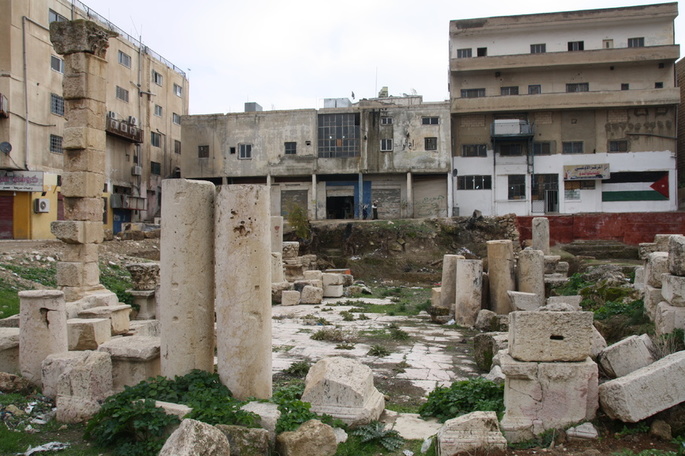In the center of the modern city of Gerasa / Jerash, a Roman bathing complex is presently investigated in close cooperation by Jordanian and French archaeologists. Located as the sole monumental building outside the protected antiquity site, the Eastern Great Baths belong with a terrain of approximate 200.000 m2 to the largest bathing complexes of the Roman orient. In some sectors, vaults are preserved to a height of 12 m.
The Great Eastern Baths of Gerasa
In April 2016, a first cut with the spate with the participation of Jordanian and Syrian refugee workmen initiated the clearance and discovery of the entire northern hall at the Eastern Great Baths of Gerasa. Few days after the hard work was awarded by a spectacular find: At the southern side of the northern hall the lower part of a colossal marble statue came to light which was found in collapsed position. The column drums excavated beside it indicate that the sculpture fell during an earth quake and suffered damage. On May 11th, 2016 the big fragment was rescued and taken out by a crane.
A subsequent study of the torso revealed that the team had uncovered a document of exceptional importance for the artistic and local history: It was the lower half of a marble statue, originally of an height of ca. 3 meters, displaying nude Aphrodite accompanied by her son Eros, the god of love. The goddess is shown to hoist a towel from the floor in order to cover shamefully her private parts. A five-line Greek inscription on the frontal and right face of the pedestal transmits the historical background of her display: In honor of the ruling Roman Emperor, a rich Gerasene citizen named Demetrius, adopted son of Asklepiodorus, dedicated this statue of Aphrodite together with the base, altar and fireplace for the municipality on ca, March 153/54 AD in an apsis at her original place of display which remains unknown. At a later date the statue was transferred in secondary use to the Eastern Great Baths of the city.
The circumstances of discovery of this important fragment gave cause for hope to find further parts of this remarkable statuary monument in the still unexcavated neighboring areas in order to support the further reconstruction of this high quality sculpture. These expectations were met in the campaign of 2017: On October 1st, 2018, less than a meter to the southwest of the find spot of the lower fragment the upper part of the body came to light. In the southern and eastern trenches numerous other fragments of marble statuary were found during the excavation campaign from September 5th to October 2oth, 2017. This new evidence will be presented in the report foreseen on the 2017 excavations.
Project Documentation
The research on the architecture, pottery and minor finds is in the responsibility of Dr. Thomas Lepaon and his French cooperators. They have been supported in the 2017by a group of 12 MA students from the German-Jordanian University Amman who absolved a stage training course in measuring and drawing under the supervision of Professor Dr. Thomas Weber-Karyotakis (GJU), Dr. Patric A. Kreuz (The University of Jordan & Ruhr University Bochum) and Ms Mada Saleh, MA (Technical University Berlin). All sculptural finds from the Eastern Great Baths of Gerasa entered a project-bound picture data base on the Sculpture of the Greco-Roman Orient. It is planned after the conclusion of the field work to make the segment “Sculpture from Gerasa” accessible to the public by internet.



